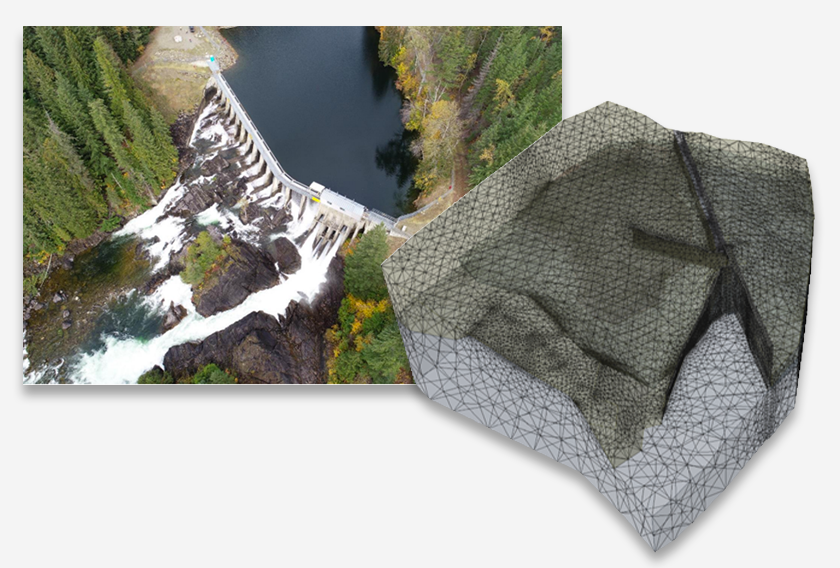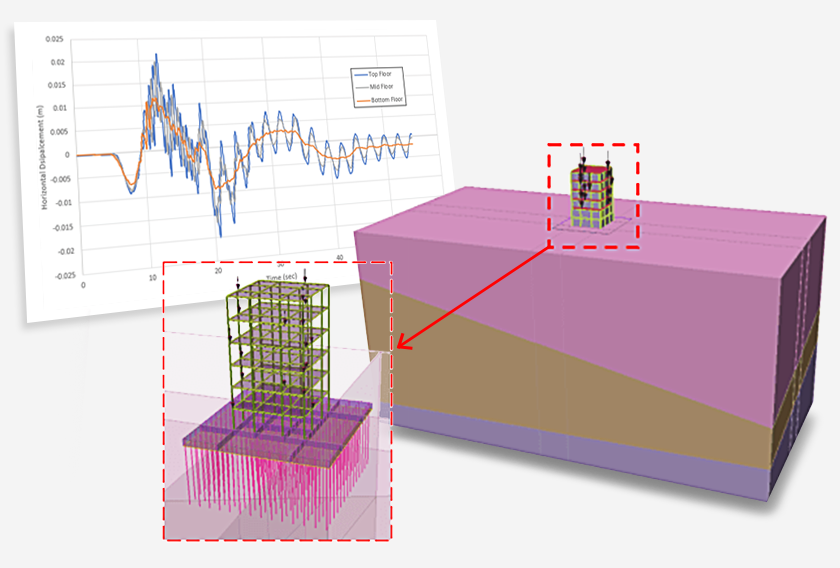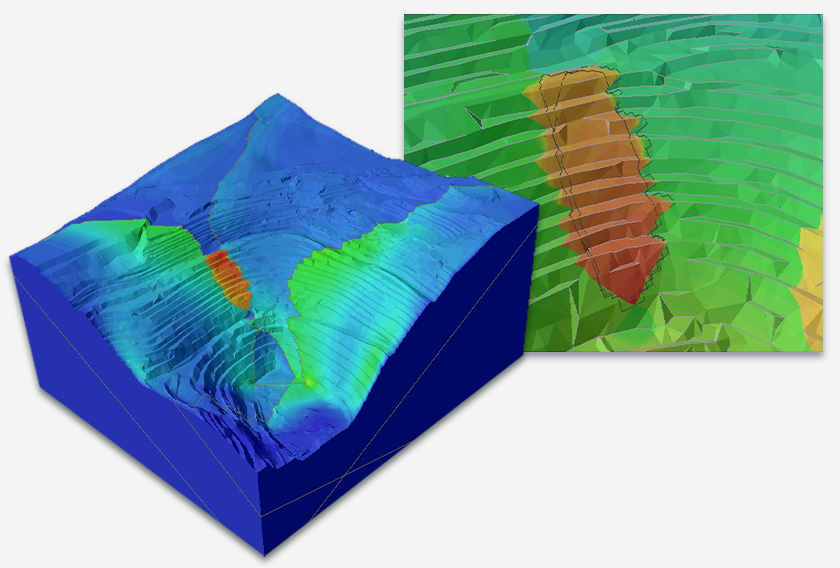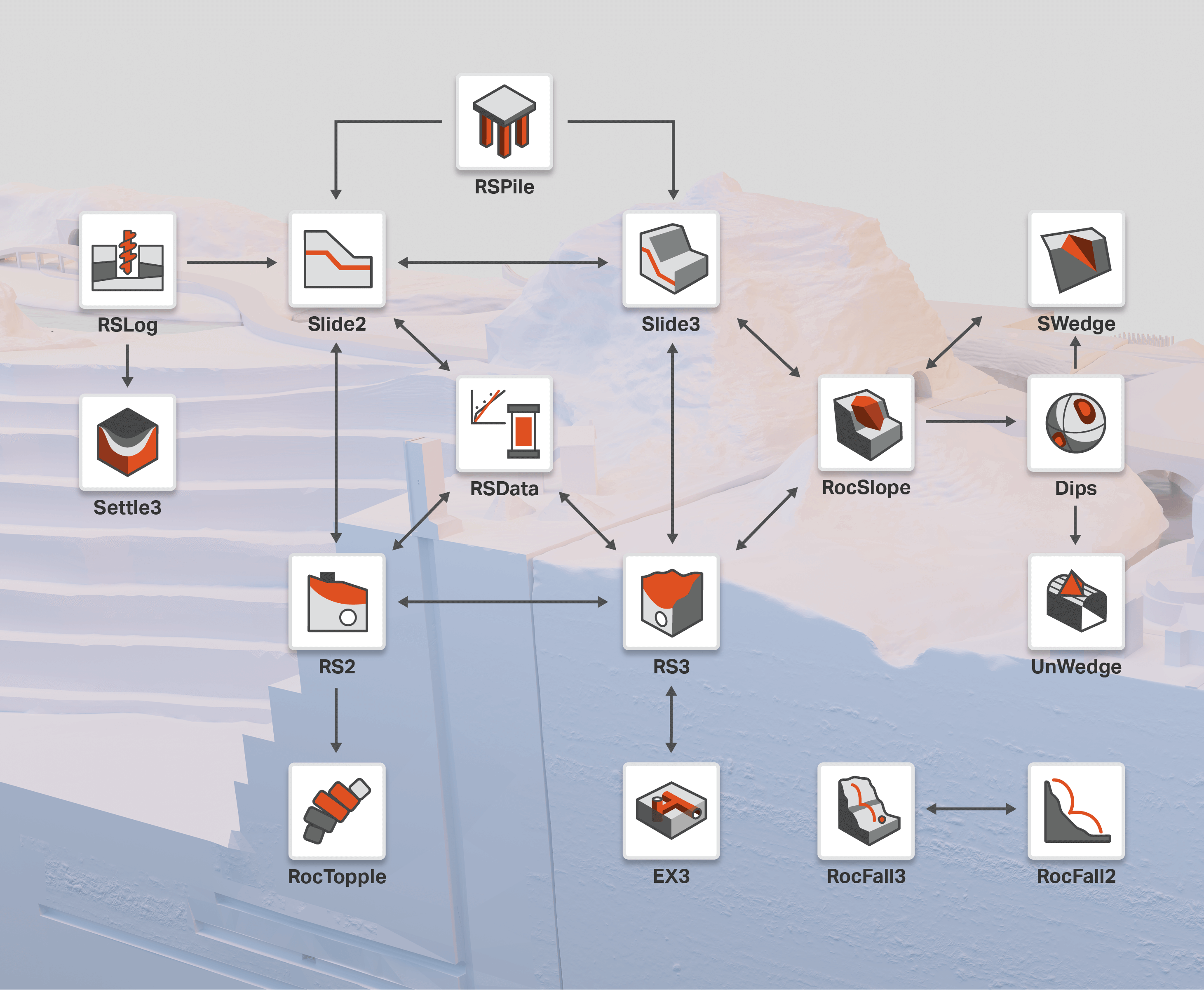Slide3 and RS3 in Action: Tailings Dam Stability Assessment Under Undrained Conditions
Tailings dam stability during construction is a significant concern as loading applications, excess pore water pressure, and local strains can lead to static liquefaction in some materials, decreasing the effective tailings shear strength. Past tailings dams failure incidents, such as the Los Frailes Dam collapse in Spain and the Mount Polley Dam failure in Canada, have shown that foundation failure in cohesive soils with low permeability can trigger tailings liquefaction. In such cases, the use of effective shear strength parameters may lead to an unreliable factor of safety assessment.
Keeping this in mind, this study focuses on the safety and stability analysis of a hypothetical tailings dam model using the Rocscience suite of software Slide3 and RS3. This assessment emphasizes the importance of adopting adequate undrained shear strength parameters to understand and consider the accurate behaviour of materials in dams while conducting an analysis.
Verification of Residual Soils and Tailings Under Shear
The 3D model of the raised centerline embankment tailings dam used in this study can be seen in Figure. 1a which was designed and built for conducting a detailed dam stability analysis. This dam model, in theory, is situated on a foundation composed of altered rock and is covered by a superficial layer of residual soil.
The steps that were involved in this evaluation are outlined below:
- A Finite Element Seepage analysis was carried out using RS3 software to calculate the porewater pressure for this model (Figure 1b). The results of the pore water pressure can be imported to Slide3 software from RS3 as pore water pressure grids.
- A stability analysis was conducted in Slide3 on a raised tailings dam with a residual soil superficial layer over an altered rock foundation.
- Lab tests such as CIUsat and CPTu’s (cone penetration test with pore pressure measurement) field tests were used to assess the behaviours of residual soil and tailings under shear.
- The tailings showed predominantly contractive behavior when the majority of the points were below the CD=70 line.
- Points distribution on QTn Graph (dimensionless normalized tip resistance) vs Fr (normalized sleeve friction) graph is shown in Figure 2. And CPTu test profiles can be seen in Figure 3.
- The State Parameter (ψ) was evaluated, and the tailings showed a tendency to shrink due to their extremely loose condition (ψ_mean equal to 0.3).
- Throughout the undrained shear test phase, the pore pressure consistently increased, indicating material contraction during the shear process under undrained conditions.

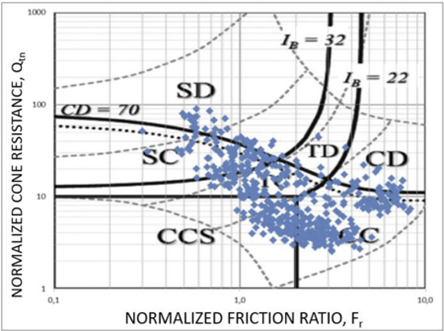
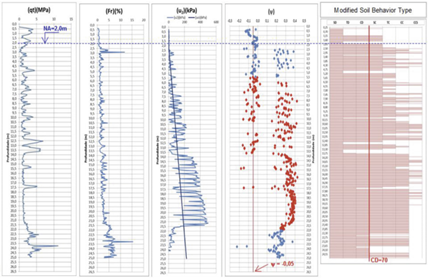
Estimating Parameters for Undrained Shear Strength
Reservoir tailings:
- The strength of reservoir tailings was calculated using the values of tip resistance (qc), sleeve friction (fs) and porewater pressure (u2) measured by the CPTu test.
- Note that this formulation works only for materials with a tip resistance below 6.5 MPa.
- The 20-30% percentile of the calculated strength was considered representative.
- This percentile corresponds to an undrained strength ratio of 0.20 for the tailings.
Foundation residual soil:
- The strength of residual soil was measured using the Direct Simple Shear (DSS) test which ensured that the sample's volume remained constant.
- By using the maximum shear stress point of the performed tests, the strength was calculated.
- The soil exhibited no significant loss of post-peak strength and the ratio of the peak undrained strength to vertical stress was 0.35.
- The residual soil undrained strength was also evaluated using the NSPT index measured from percussion soundings.
Tailings Dam Stability Analysis using Slide3 and RS3
A stability analysis was conducted on the tailings dam which involved developing a 3D model using AutoCAD Civil 3D software to create surfaces of the natural terrain, geological contacts, and the tailings reservoir. Since the Rocscience suite of software tools seamlessly supports AutoCAD models, this analysis was further streamlined by calculating porewater pressure using RS3’s 3D seepage analysis. Further, the 3D slope stability analysis was carried out in Slide3, which calculated the factor of safety using the Limit Equilibrium Method (LEM).
By employing the “Cuckoo Search” search algorithm, Surface Altering Optimization technique and the GLE/Morgenstern-Price method, the critical failure surfaces were obtained. The strength and specific weight parameters adopted for the study are summarized in Table 1, with an emphasis on residual soil and tailings.
Table 1. Shear strength and permeability parameters
Material |
γ |
C’ |
Ø’ |
Su(YIELD)/σ’ v |
k |
kv/kh |
(kN/m3) |
(kPa) |
(°) |
(m/s) |
|||
Landfill |
19 |
15 |
31 |
- |
1,3 × 10–5 |
0,25 |
Residual Soil |
16 |
21 |
30 |
0,35 |
2,0 × 10–5 |
1,00 |
Altered Rock - Bedrock |
16 |
36 |
34 |
- |
1,4 × 10–5 |
1,00 |
Drain |
19 |
0 |
30 |
- |
1,0 × 10–2 |
1,00 |
Tailing |
19 |
0 |
25 |
0,20 |
1,0 × 10–4 |
1,00 |

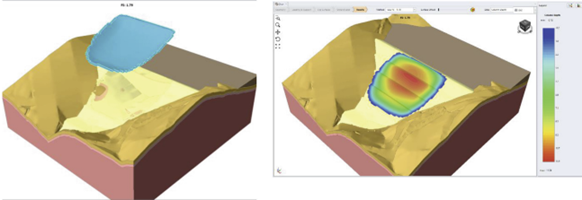
Based on the findings presented in Figure 4 and Figure 5, if a thorough analysis of the foundation's behaviour under shear was not conducted, and instead, the residual soil's effective shear strength was assumed, an inflated factor of safety would be obtained.
Lessons Learned: Residual Soil Behaviour Under Undrained Shear Cannot be Understated
The analysis of a hypothetical scenario led to some crucial findings that cannot be overlooked in real-life projects. The factor of safety (FS) values obtained from Slide3’s 3D analysis has satisfied the minimum FS criteria of greater than or equal to 1.3, recommended by the National Mining Agency in Brazil (ANM Resolution No.13) for stability analysis of liquefaction considering peak undrained shear strength.
The difference in FS values obtained from undrained (FS =1.43) versus drained foundation (FS=1.79) parameters is a reminder of the complexities and uncertainties innate to the analyses of tailings dams. Overall, this study underscores the need for a comprehensive and rigorous approach to tailings facility stability assessment to ensure their safety and prevent potential disasters.
Read the complete study to learn more about how this research work was carried out!
